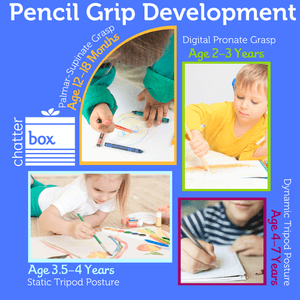Pencil Grip Development
The journey from a child's early scribbling to fine-tuning their handwriting skills takes a lot of time and practice! The goal is for a child to transition through the different stages of grip development from immature, to mature and efficient.
Stages of Pencil Grip Development
Palmar-supinate grasp:
Emerges around 1-1 ½ years
Movement initiated from the shoulder
Fisted grasp with the thumb wrapped at the top of the writing utensil, large uncoordinated movements producing random scribbles
Digital-pronate grasp:
Emerges between 2-3 years
Movement initiated from the elbow
Fingers are pointed down towards the bottom of the writing utensil with all fingers being used to hold onto the end of the writing utensil, lots of arm movements during drawing and pre-writing activities
Static Tripod posture:
Emerges around 3 ½-4 years
Movement initiated from the wrist
Hand is held with the palm facing down and the whole pads of all of the fingers hold onto the writing utensil close to the tip, movement is becoming more controlled and efficient
Dynamic Tripod posture:
Emerges between 4-7 years
Three tips of the thumb, pointer and middle fingers hold the writing utensil with the other 2 fingers tucked on the palm to help stabilize the hand on the table, the most efficient and mature grip
If a child is using an incorrect or inefficient pencil grip for their age and struggling to progress to a mature and efficient grip, or if you have other concerns with their handwriting, Chatterbox Occupational Therapists can assess their pencil grip and handwriting skills! Get started, and learn more about our Occupational Therapy services here.

